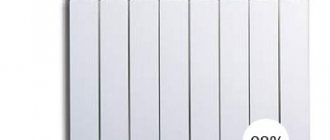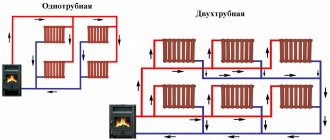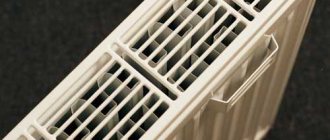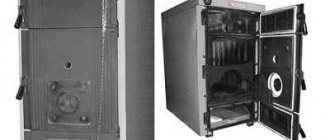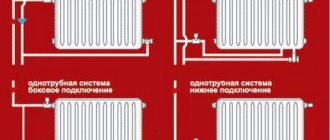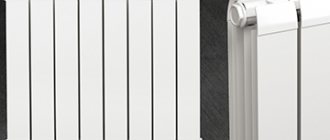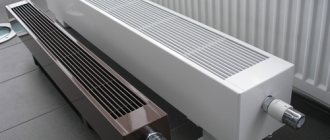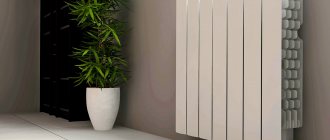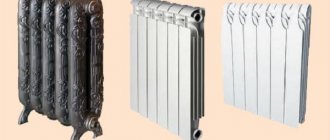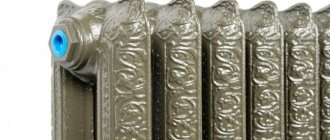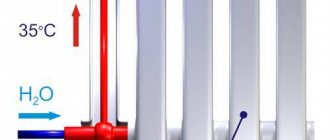Top manufacturers of heating radiators
Keep in mind! The most reliable heating radiators are produced under the following brands:
- Royal Thermo. Domestic manufacturer, not inferior in quality to foreign ones. It produces mainly bimetallic and aluminum products. The products have an ideal price-quality ratio.
- Rifar. Radiators of this brand have a long service life and have good heat transfer. Many models come with a 10-year warranty.
- Retrostyle. The company has not been producing radiators for long. Specializes mainly in cast iron models with original design.
- Valfex. A Turkish company that produces radiators using innovative technologies. The universal assortment makes it possible to choose the most suitable option.
- Axis. The activities of this company are aimed at producing steel radiators at reasonable prices. Modern Italian equipment is responsible for high quality.
Material and heat dissipation
First, let's find out whether the heat output of a radiator (as its effective thermal power is sometimes called in common parlance) is related to the material from which it is made.
With a constant temperature difference between the coolant and the room air, the thermal power of heating radiators is determined by two factors:
- Heat transfer area.
Please note: fins on sectional heating devices are present precisely to increase this area.
- Thermal conductivity of the material . The greater the thermal conductivity, the more uniformly the fins are heated, and the higher the temperature of the fin edges.
As you might guess, thermal conductivity varies for different metals:
| Metal | Thermal conductivity, W/(m*K) |
| Cast iron | 50 |
| Steel | 47 |
| Aluminum | 200 — 230 |
Due to low thermal conductivity, steel and cast iron batteries can rarely boast of developed fins, but they are present in aluminum and bimetallic (steel core and aluminum shell) devices.
Aluminum batteries are equipped with fins of a large area.
Thanks to the developed fins, aluminum radiators are the leaders in terms of specific heat transfer; The heat output of bimetallic radiators is on average slightly less due to the low thermal conductivity of the steel core; cast iron and steel appliances take last place.
What characteristics should you pay attention to when choosing a radiator for an apartment?
For your information! Criteria that you should rely on when choosing a radiator for installation in apartments with central heating:
- Operating pressure. It should be twice the pressure in the heating system, since differences in test and operating pressure lead to failure of radiators.
- Protection against water hammer. This factor directly affects the service life of the devices. It is impossible to protect yourself from water hammer in apartments with a central heating system. Therefore, it is worth giving preference to those devices that have high hydraulic shock.
- Power . High power allows you to fully heat medium-sized and large apartments.
- Lifetime. It is advisable that the device be given a maximum warranty, because such products are purchased for more than one year. Replacing batteries in an apartment is not the most budget-friendly activity.
- Easy to install. This indicator is important if you have to install radiators yourself. In this case, it is better to focus on light-weight panel structures.
Calculation by area
This is the simplest option for determining a more or less exact amount of heat required for heating. When calculating, the main starting point is the area of the apartment or house where heating is organized.
The area of each room is available in the apartment plan, and to calculate specific values for heat consumption, SNiP comes to the rescue:
- For the average climate zone, the norm for a residential premises is defined as 70-100 W/1 m2.
- If the temperature in the region drops below -60 degrees, the heating level of each 1 m2 must be increased to 150-220 W.
To calculate panel heating radiators by area, in addition to the given standards, you can use a calculator. The power of each heating device must be taken into account. It is better not to allow significant overexpenditures, because... As the resulting power increases, the number of batteries in the system also increases. In the case of central heating, such situations are not critical: there, each family pays only a fixed cost.
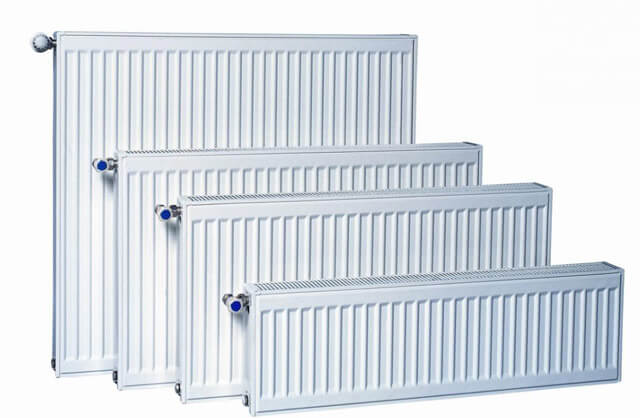
It’s a completely different matter in autonomous heating systems, where the consequence of any overconsumption is an increase in payment for the volume of coolant and the operation of the circuit. It is impractical to spend extra money, because... Over the course of a full heating season, a decent amount can accrue. By using a calculator to determine exactly how much heat is needed for each room, it is easy to find out how many sections to purchase.
For simplicity, each heating device indicates the amount of heat it produces. These parameters are usually contained in the accompanying documentation. The arithmetic here is simple: after determining the amount of heat, the resulting figure must be divided by the battery power. The result obtained after these simple operations is the number of sections required to replenish heat leaks in winter.
For clarity, it is better to look at a simple example: let’s say that you need only 1600 Watts, with the area of each section being 170 Watts. Further actions: the total value of 1600 is divided by 170. It turns out that you need to purchase 9.5 sections. Rounding can be done in any direction, at the discretion of the home owner. If there are additional heat sources in the room (for example, a stove), then you need to round down.
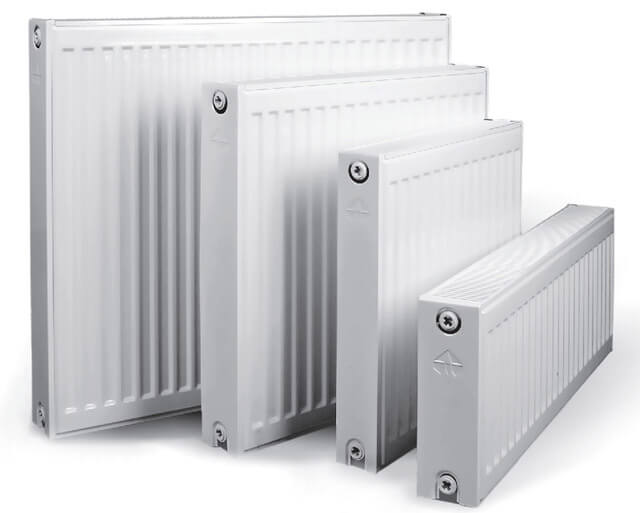
The opposite direction is calculated if the room has balconies or spacious windows. The same applies to corner rooms, or if the walls are poorly insulated. The calculation is very simple: the main thing is not to forget about the height of the ceilings, because... it is not always standard. The type of building material used to construct the building and the type of window blocks also matter. Therefore, the data for calculating the power of steel heating radiators should be taken as approximate. The calculator is much more convenient in this regard, because... it provides for adjustments to building materials and premises characteristics.
The best models in terms of price/quality ratio
Let's consider budget models of heating radiators that are of high quality.
Royal Thermo BiLiner 500 x6
This model is equipped with protection against water hammer and chemically aggressive coolants.
Radiators are available in white, gray, black, which allows you to choose the best option to suit the design of the room.
Ultra-resistant 7-level painting prevents chips and cracks on the surface.
One of the main advantages of the model is that it comes with a 25-year warranty. The design consists of 6 elements.
Specifications:
- design - wall-mounted;
- type - sectional;
- connection - lateral;
- maximum operating pressure - 30 bar;
- height - 57.4 cm;
- width - 48 cm;
- thickness - 8.7 cm;
- weight - 11 kg.
Advantages
- long warranty period;
- stylish design;
- the ability to choose a specific color;
- a light weight;
- good heat dissipation;
- high-quality coating;
- ease of installation.
Flaws
- the radiator is qualitatively painted only on the front side;
- sometimes you come across models with defective threads;
- not always high-quality assembly.
Royal Thermo PianoForte 500 x12
A model with a refined exterior, shaped like piano keys.
In addition to the original appearance, these radiators have many more features.
Innovative technologies are used in production, such as additional vertical fins, asymmetrical arrangement of sections, and the ability to use absolutely any coolant.
You can choose the radiator of this model in white, gray, black.
Specifications:
- design - wall-mounted;
- type - sectional;
- connection - lateral;
- maximum operating pressure - 30 bar;
- height - 59.1 cm;
- width - 96 cm;
- thickness - 10 cm;
- weight - 26.4 kg.
Advantages
- original appearance;
- high build quality;
- reliability;
- ease of installation;
- high heat transfer;
- assortment of colors;
- ideal value for money.
Flaws
- makes a lot of noise when touched;
- more suitable for installation under a wall without a window sill, since the heated air only goes upward;
- not always a high-quality painted surface.
Royal Thermo Revolution Bimetall 500 x4
These radiators are equipped with reliable protection against water hammer and are resistant to chemically aggressive coolants.
The structure is made entirely of bimetal.
The presence of additional fins on the collector significantly increases heat transfer.
This model is environmentally friendly and has a long service life.
Specifications:
- design - wall-mounted;
- type - sectional;
- connection - lateral;
- maximum operating pressure - 30 bar;
- height - 56.4 cm;
- width - 32 cm;
- thickness - 8 cm;
- weight - 7.28 kg.
Advantages
- ideal for use in small apartments;
- easy to install;
- good heat dissipation;
- beautiful appearance;
- it is possible to expand sections;
- high build quality;
- reliability.
Flaws
- sometimes you come across models with defective threads;
- poorly painted surface;
- slightly overpriced.
Dimensions
Modern bimetal radiators are most often supplied with an interaxal distance (between the upper and lower collector through which the coolant flows) of 300 mm, 350 mm and 500 mm. Sometimes there are models with a distance of 623 mm and 813 mm.
The dimensions of the products are always larger, since the aluminum body protrudes above and below the collectors (cores) to increase the total area of the heat-transmitting surface.
For radiators with an interaxial distance of 350 mm, you can find product heights of 400, 423, 425, 430 mm, for an interaxial distance of 500 mm - heights of 550, 560, 572, 575, 580 mm. Thus, when choosing bimetallic heating radiators, it is necessary to take into account not only heat transfer, but also the dimensions of the model - after all, it may well turn out that the radiator is too large for installation under a window (the traditional installation location).
Important: the distance for effective heating of the room from the extreme planes of the heating device to the obstacle:
- To the window sill - at least 50 mm
- To the floor - at least 60 mm
- To the wall - at least 25 mm
If the window sill is wider than usual, that is, it completely covers the heating device located underneath, it is necessary to increase the gap and/or make ventilation holes in the window sill panel. Otherwise, the window will fog up, and the quality of heating the room will significantly deteriorate.
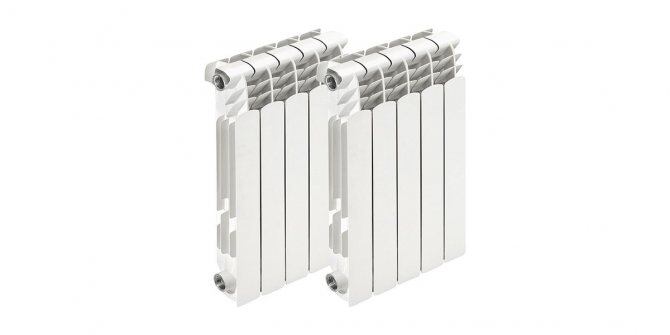
The best vertical models
The peculiarity of vertical radiators is that their installation requires a completely free wall in the room and the possibility of unnoticeably running pipes to the structure.
Note! Advantages of vertical models:
- High heat transfer rate. It manifests itself due to the large area of contact with air.
- Variety of colors, shapes, sizes. This makes it possible to choose the ideal option.
- Good heating speed. This occurs due to contact with air throughout the entire height of the room.
- Ease of installation. Each radiator comes with a set of suitable fasteners.
Disadvantages of vertical structures:
- uneven heating;
- high price;
- reduced heat transfer level by approximately 10-15%;
- steel models are heavy and therefore not suitable for installation on plasterboard walls.
Let's consider the rating of the TOP 3 best vertical radiators according to customer reviews and ratings.
Arbonia 2180 1800 450 with side connection
One of the few varieties of tubular shape.
The main feature of the model is its original exterior.
Also, this radiator allows you to fully heat the room in a short time.
Installation does not take much time thanks to the rich configuration.
Specifications:
- design - wall-mounted;
- type - tubular;
- connection - lateral;
- maximum operating pressure - 10 bar;
- height - 180 cm;
- width - 45 cm;
- thickness - 6.5 cm;
- weight - 46.1 kg.
Advantages
- unusual design;
- rich equipment;
- high build quality;
- reasonable cost;
- quickly warms up the room.
Flaws
- when installing, you need to take into account that the wall must be without a window sill;
- uneven heating of the room;
- the surface is quickly subject to mechanical damage.
Royal Thermo PianoForte Tower
A well-built battery with an incredibly original design in the form of piano keys.
The design is available in white, black, gray, so it will be easy to choose the appropriate option to suit the interior of the room.
In addition to its appearance, the device is characterized by a high rate of heating of the room.
Specifications:
- design - wall-mounted;
- type - sectional;
- connection - bottom;
- maximum operating pressure - 30 bar;
- height - 48 cm;
- width - 59.1 cm;
- thickness - 10 cm;
- weight - 13.2 kg.
Advantages
- unusual exterior;
- high build quality;
- convenient way of eyeliner;
- good power;
- high quality coating;
- a light weight.
Flaws
- given the design, a small number of colors to choose from;
- Not exclusively lower eyeliner is convenient for everyone;
- high price.
Zehnder Charleston 2180 1792 with bottom liner
The perfect combination of original design and high quality.
The white design will harmoniously fit into any interior.
Installation will not take much time, given that all the necessary parts are included in the kit.
The radiator quickly warms up the room and has high heat transfer.
Specifications:
- design - wall-mounted;
- type - tubular;
- connection - bottom;
- maximum operating pressure - 10 bar;
- height - 17.92 cm;
- width - 13.8 cm;
- thickness - 6.2 cm;
- weight - 8.2 kg.
Advantages
- high heat transfer;
- high-quality assembly;
- stylish design;
- convenient installation;
- a light weight.
Flaws
- high price;
- even the smallest damage is visible on the surface;
- The radiator is well painted only on the front side.
It's profitable with SANTEKHPROM!
Our company is one of the leading suppliers of bimetallic heating radiators with increased heat transfer. SANTEKHPROM's assortment includes models with center distances of 300 and 500 mm, depths of 90, 95 and 100 mm. The section width in all models is 80 mm.
Differences in the thermal output of one section make it possible to easily select the required type of radiators and the required number of sections without overpayments.
Our specialists will help with calculations and selection of a suitable model, advise on connection methods, and recommend the necessary additional components. Call today to keep your home warm this winter!
The best panel models
Important! Panel radiators are a cast structure, which can be an excellent replacement for Soviet cast-iron appliances.
The advantages of such models include:
- Multifunctionality. The devices combine both a radiator and a convector. They heat the room well and do not require the purchase of additional heating devices.
- Ability to regulate temperature. This can be done both manually and automatically.
- High level of heat transfer. A much larger surface area is in contact with air compared to other types of radiators.
- Affordable price.
Disadvantages of panel radiators:
- the radiator cannot be left for a long time without coolant, otherwise corrosion will form;
- water with high acidity will cause the device to begin to rust from the inside;
- susceptibility to water hammer.
Let's look at the best panel batteries, according to consumers.
Kermi FKO 22 500 1600
This model is an excellent option for walls with windows, where the window sill is slightly lower than usual.
For installation, special fasteners are located on the back of the panel.
Internal U-shaped fins act as convectors for maximum heat transfer.
The sides are protected by bars.
Specifications:
- design - wall-mounted;
- type - panel;
- connection - lateral;
- maximum operating pressure - 10 bar;
- height - 50 cm;
- width - 160 cm;
- thickness - 10 cm;
- weight - 46 kg.
Advantages
- high build quality;
- ease of installation;
- reliability;
- nice design;
- low cost;
- good heat dissipation.
Flaws
- if handled incorrectly, the metal can crack, especially with regard to the quality of the coolant;
- fasteners must be purchased separately;
- When touched sharply it makes a lot of noise.
Axis Classic 22 500 700
A complete heating device at an affordable price.
This model can be used in closed water heating systems.
The operating temperature is slightly higher compared to similar radiators.
Installation is hassle-free as everything needed for installation is included in the kit.
Specifications:
- design - wall-mounted;
- type - panel;
- connection - lateral;
- maximum operating pressure - 9 bar;
- height - 50 cm;
- width - 70 cm;
- thickness - 11 cm;
- weight - 19.96 kg.
Advantages
- a light weight;
- rich equipment;
- laconic exterior;
- good heat dissipation;
- low price.
Flaws
- not always high-quality assembly;
- weak coating - quickly damaged;
- bulky design.
Kermi FKO 22 200 1000
The compact model is an excellent heating device for a room with a low window sill.
Installation is hassle-free, thanks to the presence of special fasteners.
Inside, the design is made so that the radiator functions with maximum heat transfer.
There are grilles on the sides for added protection.
Specifications:
- design - wall-mounted;
- type - panel;
- connection - lateral;
- maximum operating pressure - 10 bar;
- height - 20 cm;
- width - 100 cm;
- thickness - 10 cm;
- weight - 10.5 kg.
Advantages
- reliability;
- high build quality;
- a light weight;
- laconic appearance;
- ease of installation.
Flaws
- some consumers complain that after a while the batteries of this model leak;
- if you touch the radiator, it starts to make a lot of noise;
- poor paint coverage.
Axis Ventil 22 500 1200
Standard radiator both in appearance and functionality.
The device has good heat dissipation.
It doesn't take much time to install. Installation is carried out through the bottom connection.
The operating temperature reaches 120 degrees, which is slightly more compared to similar models.
Specifications:
- design - wall-mounted;
- type - panel;
- connection - bottom;
- maximum operating pressure - 9 bar;
- height - 50 cm;
- width - 120 cm;
- thickness - 11 cm;
- weight - 33.76 kg.
Advantages
- high heat transfer;
- discreet design;
- convenient installation;
- reliability;
- long service life.
Flaws
- high price;
- not available in all stores;
- heavy weight.
Radiator assembly
To get a positive result, you should take care of the quality of the radiator gaskets. As a rule, paronite options are used, which have sufficient strength and durability. You also need to check the condition of the nipples, especially the quality of the threads and the integrity of the sockets. There should be no chips on them, and the cutting must be complete and uniform.
By following the sequence of actions, with due attention, you can assemble it yourself. To do this you will need:
- Place the radiator and prepared sections on a flat surface.
- Move the sections and place nipples with gaskets between them.
- Carefully begin to tighten the nipple. Since it has a left-hand thread on one side and a right-hand thread on the other, when twisted, the sections simultaneously attract each other. Knowing this feature of the nipple, even a beginner will understand how to remove a section from a bimetallic radiator. Just twist it in the opposite direction and the sections will move away from each other. The work is carried out with a special radiator wrench.
- After all the nipples are inserted and lightly tacked, they must be tightened tightly, making the same number of turns. This is important to avoid distortions. If 3 turns were made on one nipple, then the same amount of movement is produced on all the others.
It is possible to understand that the assembly of the bimetallic radiator sections was carried out correctly only by carrying out the appropriate test.
The best sectional models
Sectional radiators are distinguished by their modern design, ease of installation, and long service life .
The advantages of such devices include:
- high heat transfer rate;
- aesthetically attractive appearance;
- various variations of designs and colors;
- good efficiency.
Disadvantages of sectional radiators:
- take longer to heat up than other varieties;
- small heating area;
- uneven heating of the room.
Let's consider the rating of the best sectional models on the heating appliance market.
STI Nova 500
Sectional radiator with a laconic design and high quality workmanship.
The device is made of cast iron, but in appearance it does not differ from modern radiators.
Able to withstand high coolant temperatures, as well as increased short-term pressure.
With its help, you can fully heat a room up to 20 square meters in size.
Specifications:
- design - wall-mounted;
- type - sectional;
- connection - lateral;
- maximum operating pressure - 12 bar;
- height - 58 cm;
- width of one section - 6 cm;
- thickness - 8.5 cm;
- the weight of one section is 4.2 kg.
Advantages
- low weight as for a cast iron product;
- modern design;
- quickly warms up the room;
- high-quality coating;
- low price.
Flaws
- not the most convenient standard width, it is better to buy in separate sections;
- difficult to install in rooms with plasterboard walls;
- the paint chips easily - must be protected from mechanical damage.
Rifar Base 500
A special feature of this model is its reliability, which is ensured by a special protective coating both outside and inside.
The unit has a pleasant appearance, so it will be a chic addition to any modern interior.
The design is made in such a way that heat comes not only from above, but also dissipates forward. This allows you to heat the room quickly and efficiently.
Specifications:
- design - wall-mounted;
- type - sectional;
- connection - lateral;
- maximum operating pressure - 20 bar;
- height - 57 cm;
- width of one section - 8 cm;
- thickness - 10 cm;
- the weight of one section is 1.92 kg.
Advantages
- exquisite design;
- high-quality heating with good heat transfer;
- reliable design;
- high quality workmanship;
- reliability;
- high quality coating.
Flaws
- heavy weight;
- high price;
- Requires maximum care during transportation.
Royal Thermo Vittoria 500
Non-standard fins on these radiators give an unusual appearance to the entire structure.
Finning is not only an aesthetic move, it also increases the performance of the unit, making the room warm and cozy.
Great for rooms up to 20 square meters.
In addition, seven-level painting provides reliable anti-corrosion protection.
Specifications:
- design - wall-mounted;
- type - sectional;
- connection - lateral;
- maximum operating pressure - 30 bar;
- height - 56 cm;
- width of one section - 8 cm;
- thickness - 8 cm;
- the weight of one section is 1.65 kg.
Advantages
- stylish design;
- good heat dissipation;
- a light weight;
- high quality coating;
- reliability;
- long warranty period.
Flaws
- high price;
- the quality of the coating is good only on the front side;
- not always high-quality assembly.
Konner Modern 500
The perfect combination of style and high quality heating.
The outer surface is perfectly processed - has no unnecessary bulges. Therefore, it fits easily under the window sill to the wall.
It is compact and can be hidden well under a curtain, although it can become a harmonious element of a room interior.
In appearance, this model is similar to the standard aluminum one, but is superior in quality.
Specifications:
- design - wall-mounted;
- type - sectional;
- connection - lateral;
- maximum operating pressure - 12 bar;
- height - 60 cm;
- width of one section - 6.4 cm;
- thickness - 9.6 cm;
- the weight of one section is 4.9 kg.
Advantages
- beautiful exterior;
- rich equipment;
- good heat dissipation;
- versatility;
- endurance;
- reliability.
Flaws
- the coating is easily scratched;
- not very high quality painting, sagging is visible;
- high price.
ROMMER Optima Bm 500
This model occupies a leading position in sales due to its high quality at a budget price.
The device has great endurance. Also equipped with reliable corrosion protection.
Each section undergoes a three-stage test, which guarantees the highest quality to the end consumer.
Specifications:
- design - wall-mounted;
- type - sectional;
- connection - lateral;
- maximum operating pressure - 18 bar;
- height - 56 cm;
- width of one section - 7.7 cm;
- thickness - 7.8 cm;
- the weight of one section is 1.22 kg.
Advantages
- beautiful exterior;
- budget cost;
- compactness;
- high quality external coating;
- reliability;
- endurance.
Flaws
- short warranty period;
- good painting only on the front side;
- For installation you need to buy additional components.
Real power: factors
It would seem that calculating the number or size of heating devices based on the data we provide should not create any problems:
- To calculate the number of sections, it is enough to divide the target power required to heat the room by the heat flow of each section;
- Welded thermal heating radiators (registers) are selected by substituting their dimensions into the formula a couple of paragraphs above.
In practice, however, a number of additional factors influence the heat transfer of batteries.
Connection
With a large length of the device and a traditional lateral connection, the last sections can warm up much less than those closest to the connection. The reason is the slow circulation of coolant in them: the main volume of water passes through the first few sections.
The problem is solved by changing the connection diagram to diagonal or “bottom-down”. In the latter case, the radiator is equipped with an air vent in the top plug.
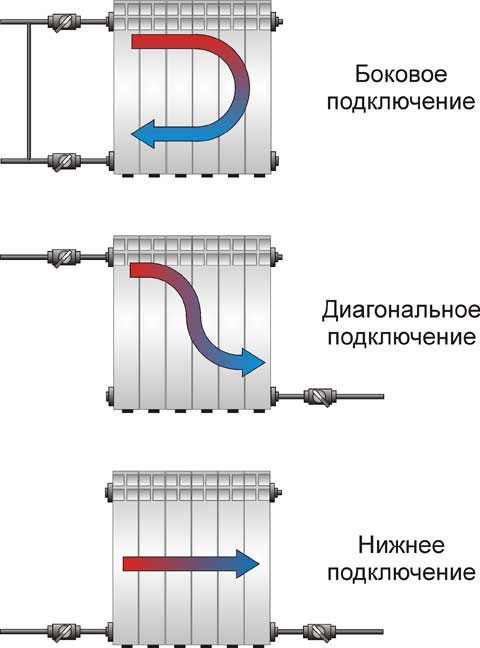
Possible connection diagrams.
Line diameter
Heat transfer is often limited by insufficient supply throughput.
Its diameter should be selected using a simple algorithm:
- Pipes DN15 (1/2 inch) are sufficient for a battery up to 9 sections long;
- When the number of sections is 10 or more, the diameter increases to DN20 (3/4 inch).
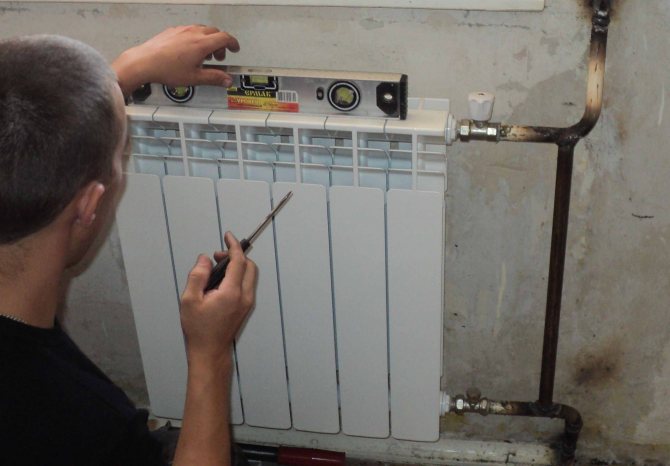
The typical size of pipes in apartment buildings is DN20.
Siltation
The thermal power of cast iron heating radiators is often limited by the large amount of silt and sand in the lower collector of the last sections. The large internal volume of the sections entails a low speed of coolant movement in them; as a result, all suspended matter precipitates.
There is only one treatment method - washing:
- In summer, instead of the lower blind plug, a flushing tap is installed;
- After the heating starts, a certain amount of water along with silt and sand is discharged into the sewer through pipes.
Painting
Older cast iron sections often bear several layers of paint. With a total thickness of 2-3 millimeters, they reduce heat transfer by 15-20%.
Coolant temperature
Manufacturers indicate thermal power values for Dt=70 (that is, at +20 in the room the coolant should be heated to 90C). If the Dt value is half as much (the battery is heated to 20+35=55C), the heat flux value can be divided by 2.
Location
Wide window sills, boxes, screens and installation of the battery close to the floor affect the movement of convection currents around it, again limiting heat transfer.
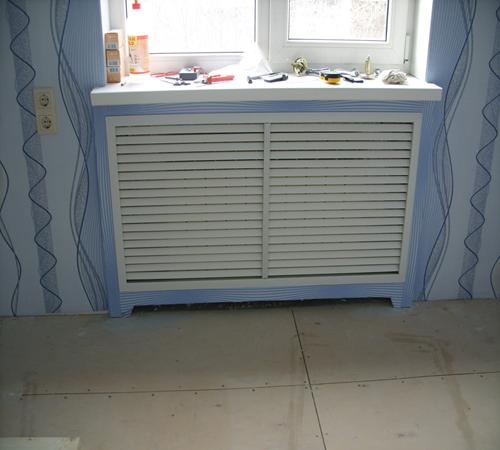
The box in the photo will reduce the heat transfer of the radiator by at least a third.
Fondital
The company was founded in 1970 in Weston (Italy). All these years the company has been working in the field of design and production of heating systems. Today, the small enterprise has grown into a powerful enterprise with several large production facilities.
The bimetallic Fondital Alustal model is optimized for installation in the central heating system of shared multi-storey buildings. Reviews about the company are extremely positive. Let's look at the parameters of Fondital Alustal:
- Working pressure – 40 atm.
- The heat output of one section is 190 W.
- The maximum coolant temperature is 110 0C.
- Hydrogen indicator – 7-10 pH.
- Section volume – 0.14 liters.
- Section weight – 1.23 kg.
- The inlet diameter is 1 inch.
- The color of the radiator is white.
- Warranty – 20 years.
Noteworthy is the excellent heat transfer with a small volume and weight of the section. This is not the most budget model, but it is worth the money that the manufacturer asks for it.
Advantages and disadvantages of cast iron heating devices
"Pros":
- working pressure up to 10 bar;
- high resistance to aggressive environments and pollution;
- high corrosion resistance;
- high heat capacity.
"Minuses":
- heavy weight;
- high thermal inertia – does not allow you to quickly adjust the temperature;
- needs periodic cosmetic repairs;
- poor resistance to strong water hammer.
The heat transfer values of cast iron heating devices are in the range of 100 - 200 W per section and directly depend on the standard sizes. When calculating heat transfer, as a rule, the coolant temperature is taken as a basis at 90 degrees. But if it is produced for apartments with centralized heating, then it should be taken into account that this system does not maintain such a coolant temperature.
